Blog
September 17th, 2011
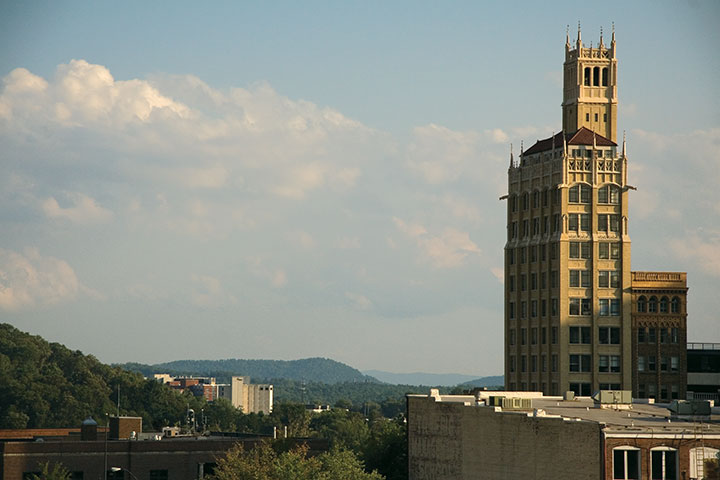
Many of my favorite towns (Boulder, Missoula, Portland, the other Portland, Duluth, Tacoma, Providence, etc.) seem to be kindred spirits to one another. There’s something about the coming-together of historic architecture, blue-collar grittiness, a population full of creative types and surrounding natural beauty that … well, for which I’m a total sucker. So based on all the reports over the years I’ve had about Asheville, I knew it was going to be my kinda place.
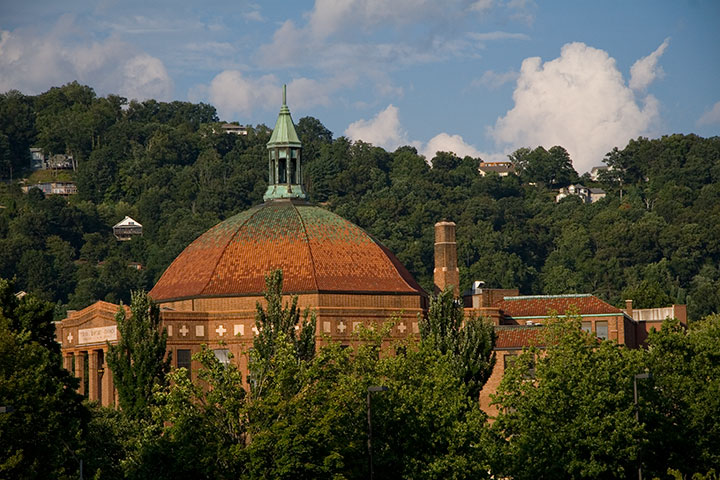
When Jessica and I were there last month for the Ladies of Letterpress Conference, we made sure to give ourselves plenty of extra time to go exploring.
Asheville is nestled in the thick of the Blue Ridge Mountains, which turned nearly every direction we looked into a beautiful panorama.
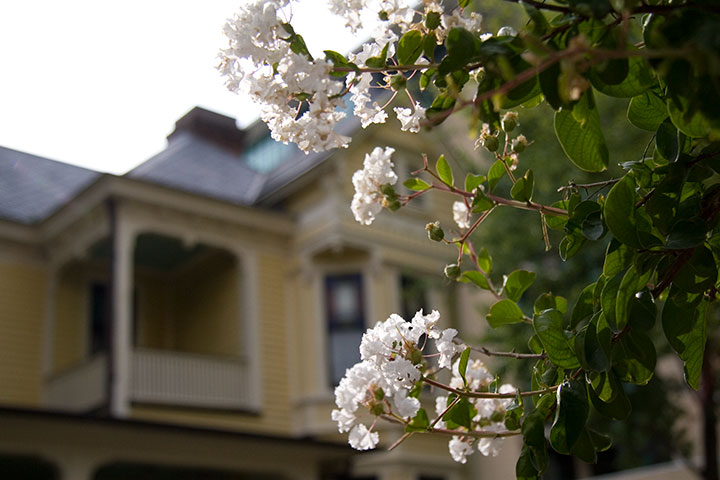
The lush, southern climate gave us the feeling that we were walking through an urban greenhouse. Everything was in full bloom and living color.
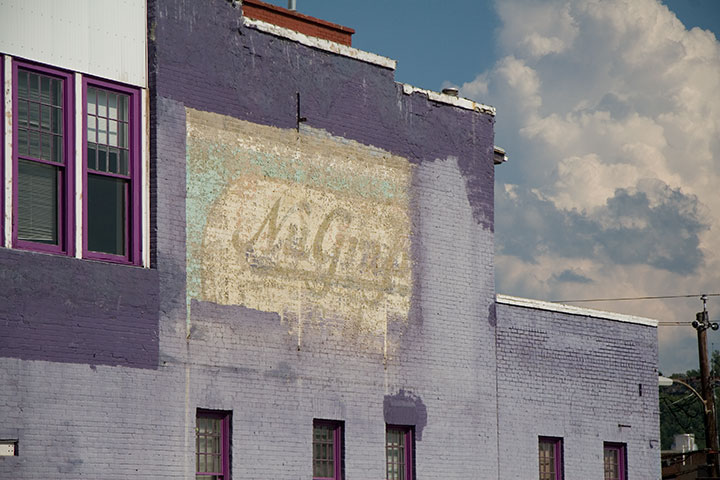
The city’s history is visible around every well-preserved corner.
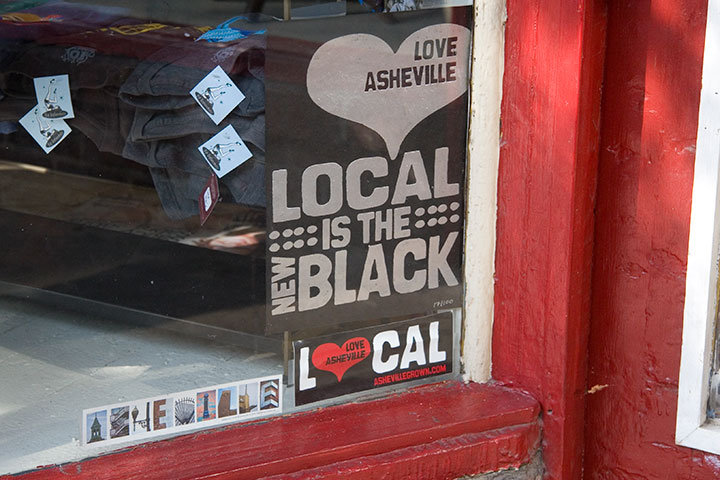
Unfortunately, that preservation is often an accidental outcome in towns that are slowly withering—but that was far from the case here. Despite an economically troubled past, Asheville is a vibrant, active city, complete with a fierce sense of local pride. We saw some variation of these signs in every shop and restaurant window, over and over again. (Hint, hint, Tacoma!)
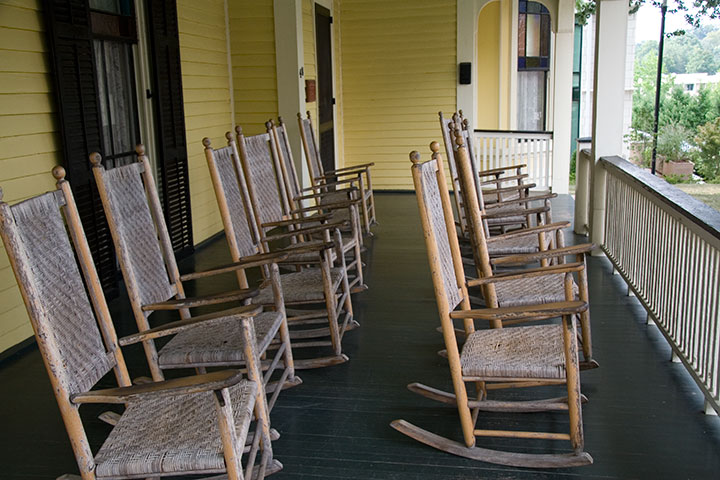
But above all, there was a comfortable sense of down-home warmth in every quarter. Everyone we met was sweet as pecan pie, and the whole place seemed to invite us to settle in and relax. And the rocking chairs! I swear, we saw them everywhere—even at the airport! That’s a tradition I can get behind—I mean, sit down upon.
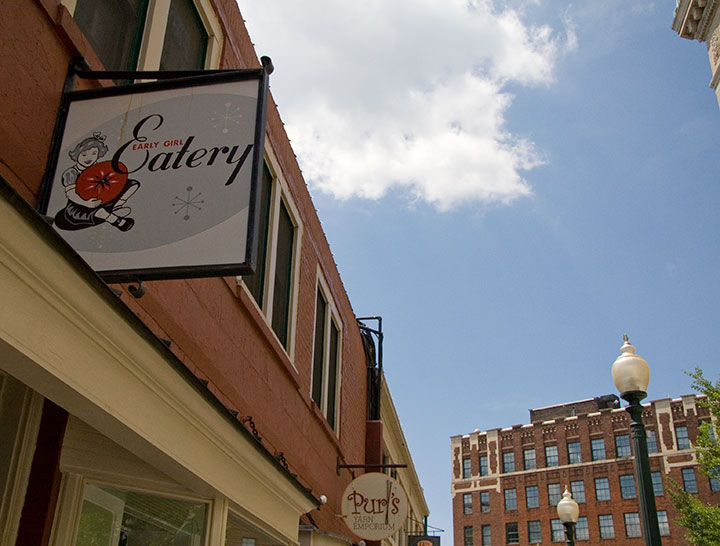
I could go on and on all day about Asheville’s charms as a city, but what I really want to talk about is the food. Oh, the food. And I know that saying so doesn’t exactly make me your typical Yankee, but I have a real thing for Southern cuisine. And after trying a new restaurant at every interval for five days, I’m convinced that it’s nigh impossible to have a bad meal in Asheville.
I’ll never understand the point of chain restaurants. When I travel, I’m not interested in the generic food you can get anywhere in America—I want local flavor. When in Rome, you know? So whenever I’m in a new place, I usually order whatever the restaurant is particularly known for, which is often some sort of local specialty. It’s never steered me wrong yet.
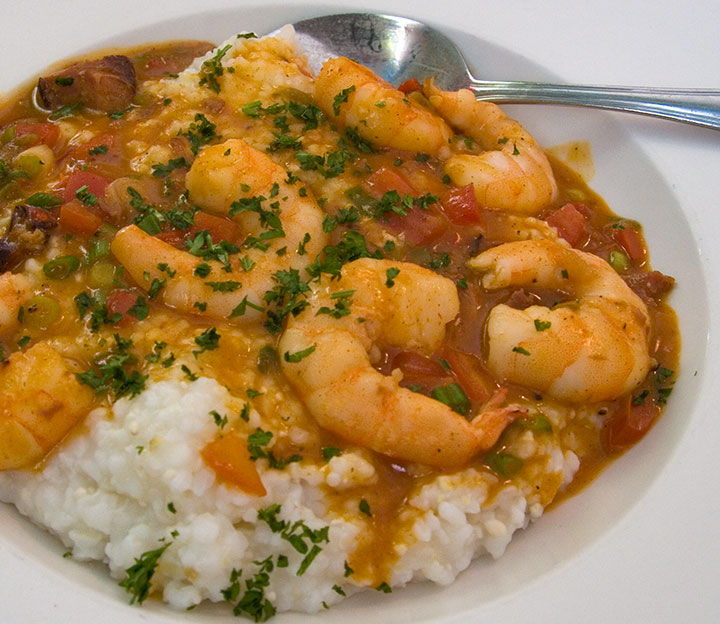
So at the Early Girl Eatery, I had the shrimp n’ grits. What’s more Southern than that? And more importantly, what could possibly be more tasty? As if that weren’t enough, the garnish on the grits was the fact that everything on the menu was locally source, and whenever possible, organic. Plus, they served the real, no-kidding, hard-core stone-ground coarse grits—the ones the Tailor and I love so much that we actually order them from a North Carolina mill and have them shipped out west as one of our staple grains. (Yes, I know we’re weird.)
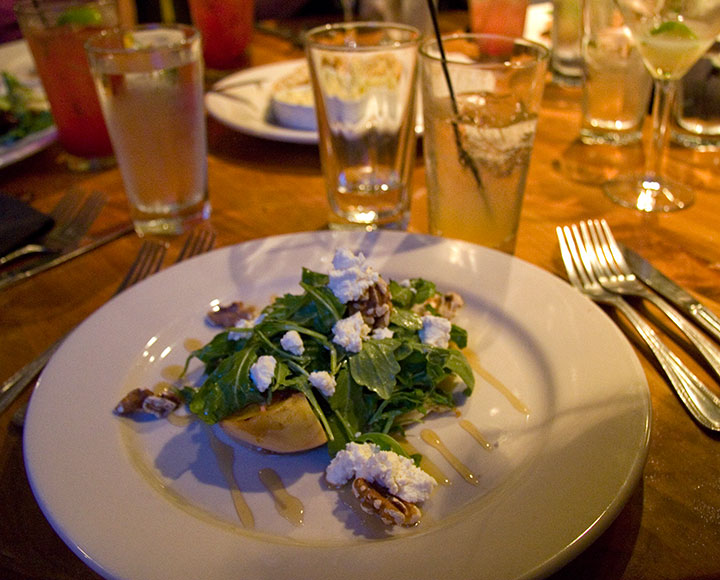
The Southern boasted both local and seasonal fare (and terrible lighting for photographs, sorry), and their peach, pecan, goat cheese and honey salad was like summer on a plate.
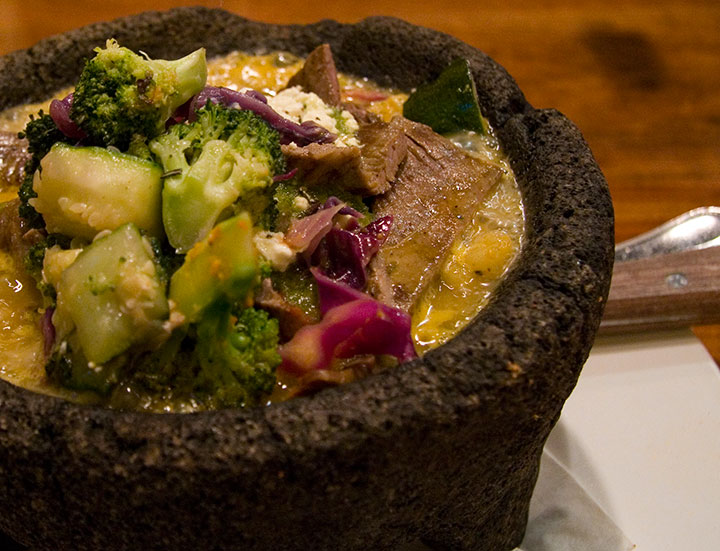
When a large group of letterpress folks joined us at Salsa’s, Southern cookin’ wasn’t exactly on the menue, but I stuck with my rule-of-thumb about the house specialty, and as usual, it was the right choice. This time I ordered their famous molcajete, a traditional Mexican mortar-and-pestle carved out of basalt, heated to something like earth-core temperatures, and filled with a molten and unbelievably delicious stew. The secret ingredient was goat cheese again, which is always a-okay with me. Besides, for someone who loves nerdy scientific things like specific heat, this dinner took the cake—even though it was nearly an hour before I could eat it without my face melting.
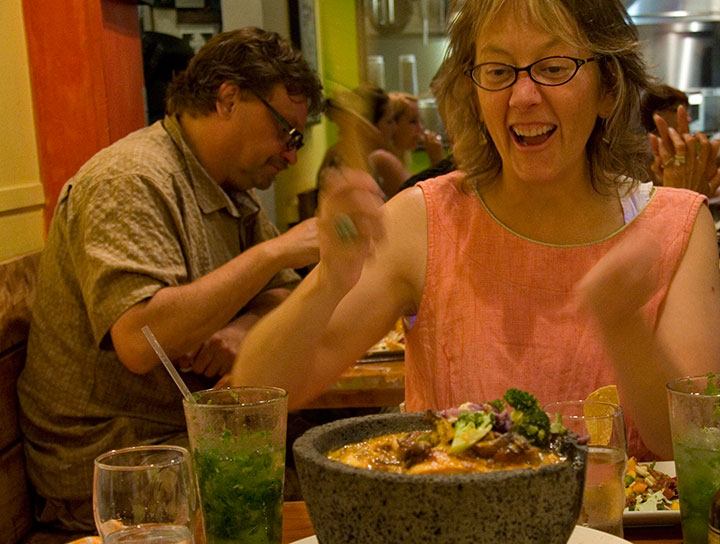
(Jessica was a fan of the molcajete, too.)
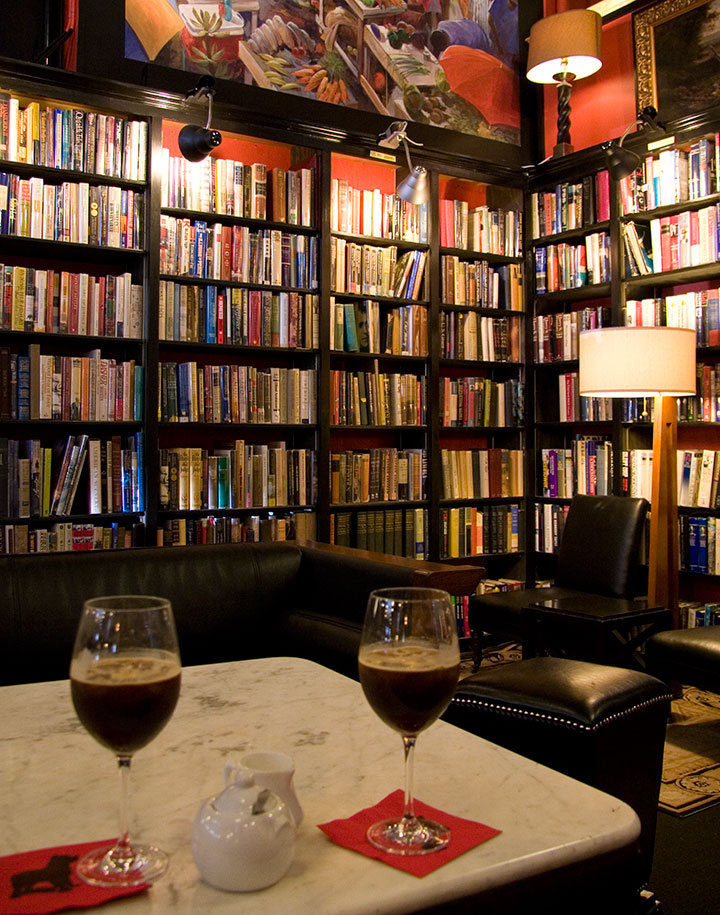
Now, I like lemonade, sweet tea and unsweet tea as much as the next gal, but I’ve always been a coffee drinker. And after three years as a transplanted Northwesterner, I’m a total convert to the coffee culture; a late-morning walk just doesn’t feel right without a cuppa. It was 95 muggy degrees outside, so an iced Americano hit the spot—and at the Battery Park Book Exchange, they’ll serve it to you in snazy wine glasses and let you while away the whole caffeinated day paging through the impressive North Carolina section.
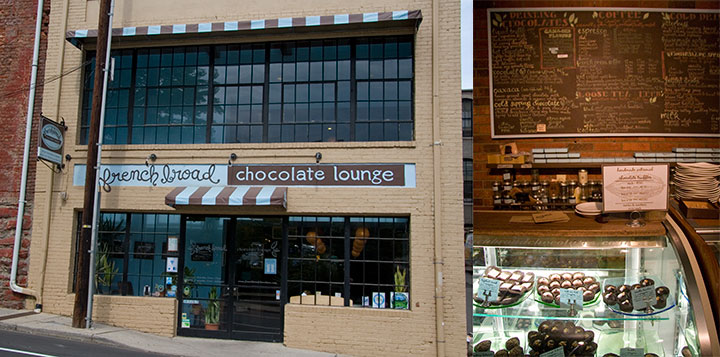
One of the people we befriended at the conference is an Asheville native who let us in on the secret about where to get the best dessert in town. Handmade chocolates. ‘Nuff said.

Still, it was the Southern classics I was the most hungry for—like this gigantic sweet potato pancake at the Tupelo Honey Cafe. It came garnished with spicy pecans and escorted by a side of grits with—you guessed it—goat cheese. Like nearly every other meal I had in Asheville, it was light and deftly made (though impossible to finish!), and completely unlike the heavy, greasy stereotype people have in their heads. With each bite I was more and more baffled by the idea that anyone could dislike Southern food.
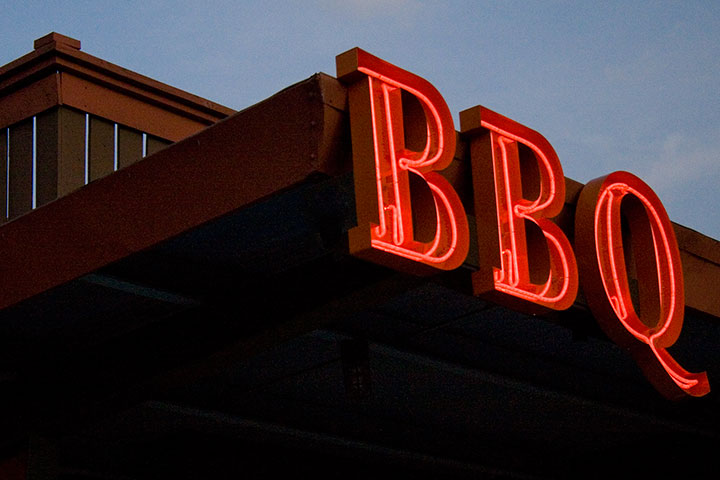
Of course, no sojourn below the Mason-Dixon Line would be complete (for omnivores, at least) without a taste of authentic, heart-attack-inducing Southern barbeque. To get our fix, Jessica and I headed for Luella’s.
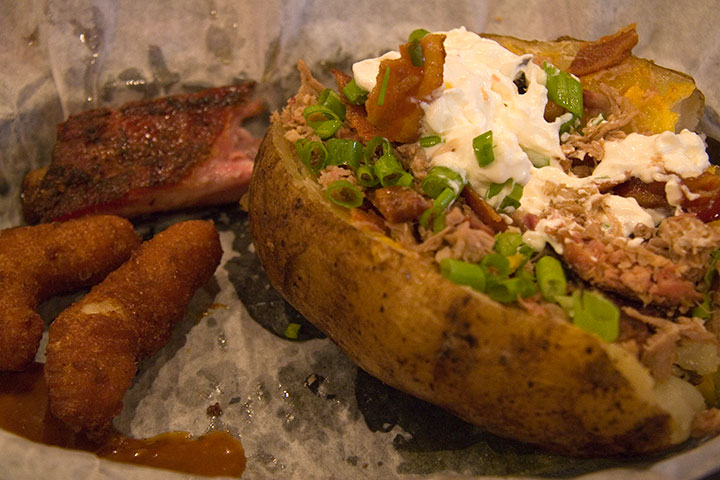
Neither of us could decide, so we ended up eating family-style and sharing everything. I picked the giant stuffed baked potato with everything plus the kitchen sink and a coronary on top (shown here with a bit of Jessica’s spare ribs). Which was fantastic, truly, but it was the hush puppies that stole the show. Best. Freaking. Hush puppies. Ever. I think the secret is in the shape—greater crispy-to-fluffy ratio. Yum.

But my favorite meal of the trip was one that will probably live in my all-time top ten forever: fried-green-tomato eggs Benedict (with a side of grits, natch!) at the Over Easy Cafe. I still dream about that one.
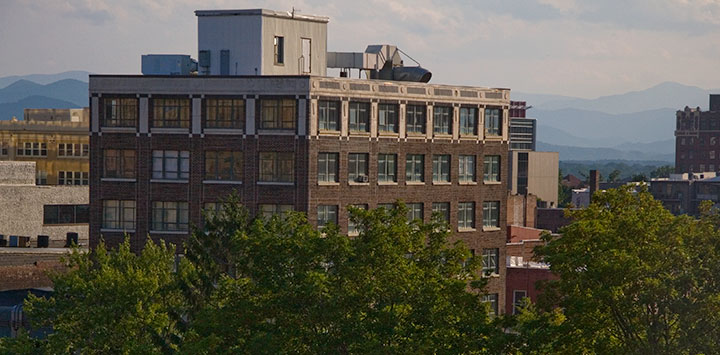
I’m also still dreaming of that blue haze. Whether it’s for the local flavor or the letterpress gals, the hush puppies or the hills, you can bet I’ll be back.
August 17th, 2011
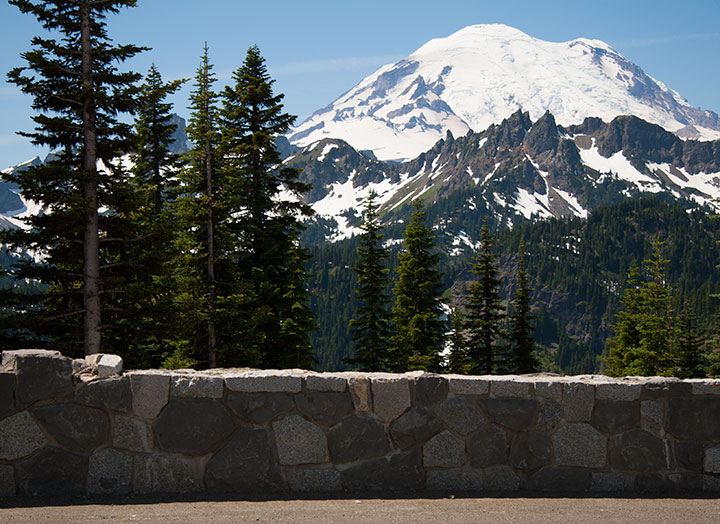
Whenever the Tailor and I do our annual peach haul from the other side of the Cascades, we like to take the back road. That way, we get to take in the mountain air,

visit every orchard along the way,
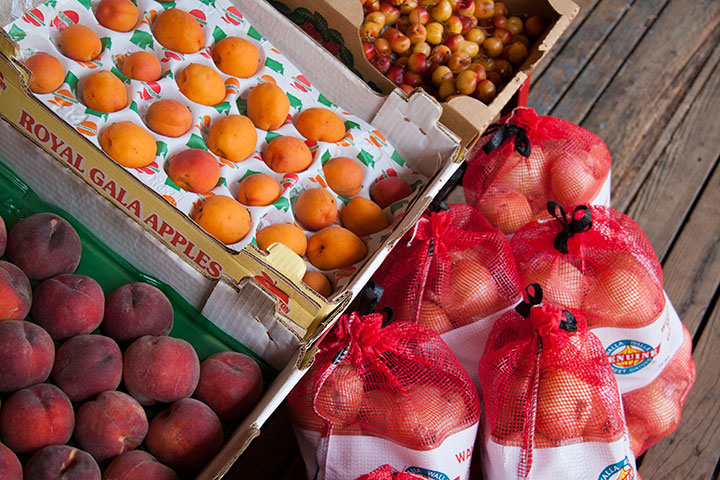
Have our pick of the best farmstands,
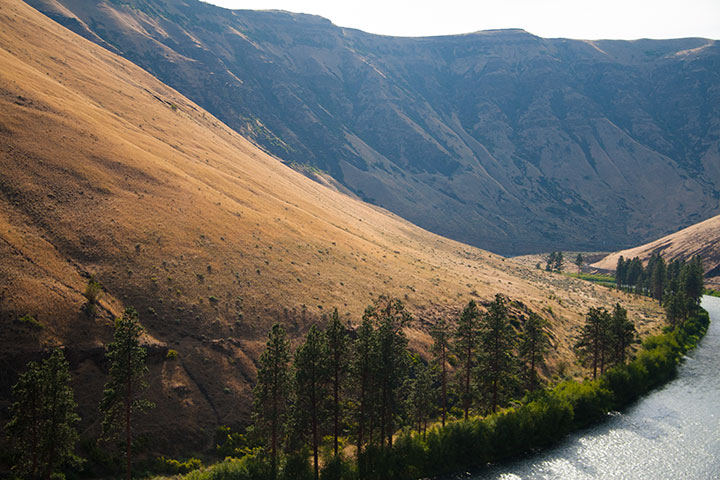
and take the time to find out what’s beyond the next bend in the road.
July 20th, 2011
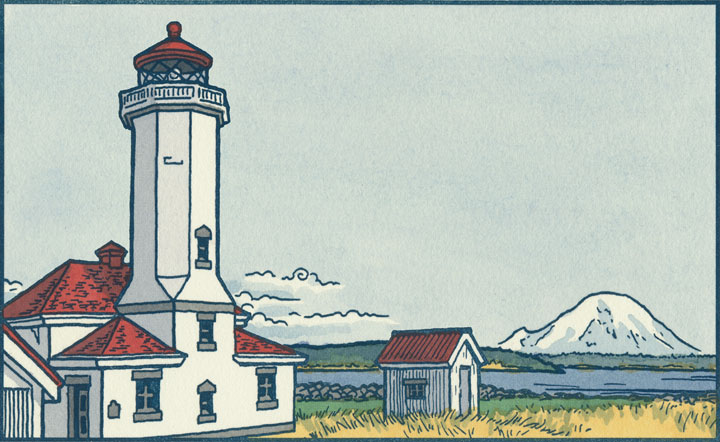
As you may have already noticed, I kind of have a thing for lighthouses.

It’s probably no surprise they’ve cropped up in my work lately, since my corner of the world is fair teeming with them.

But I even find myself sneaking them into other projects, even when it’s not strictly necessary.

So you can imagine my excitement on my trip back East,
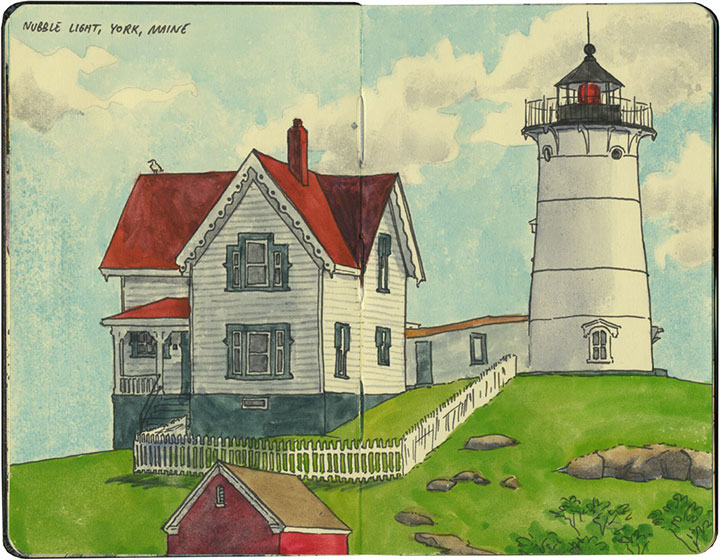
when there seemed to be a beacon
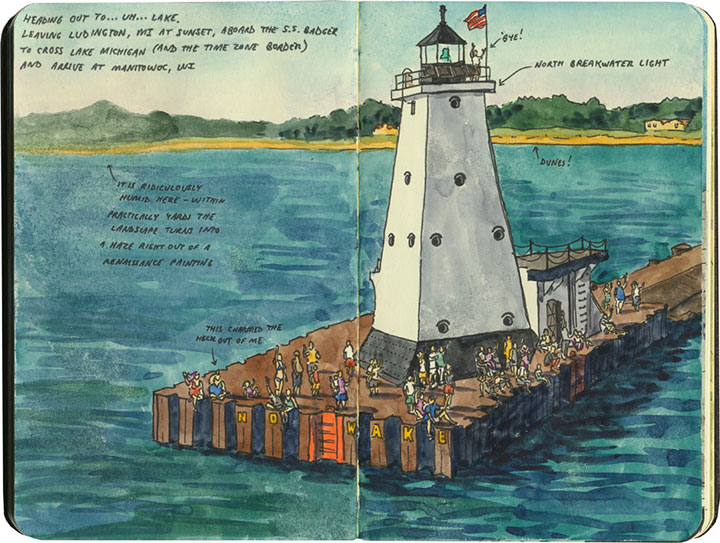
around every corner.
Best keep a sharp eye out—
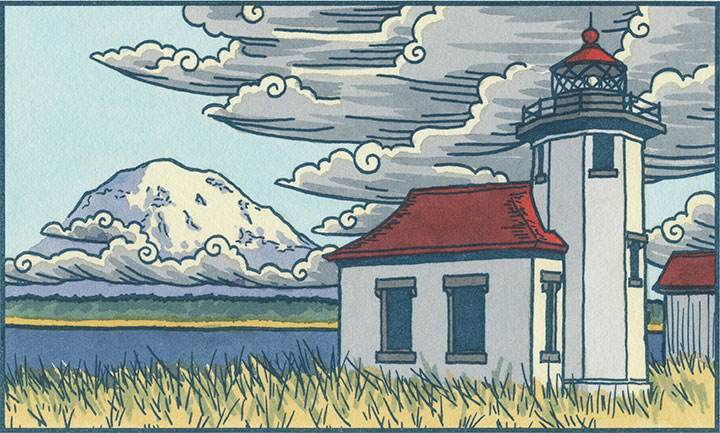
I have a feeling there’ll be more lighthouses popping up here in future.
July 13th, 2011

My next stop on the trip was one I would have made anyway, just for the sheer natural beauty. But what really happened is that I let my inner movie geek take over. Film buffs: recognize that location?
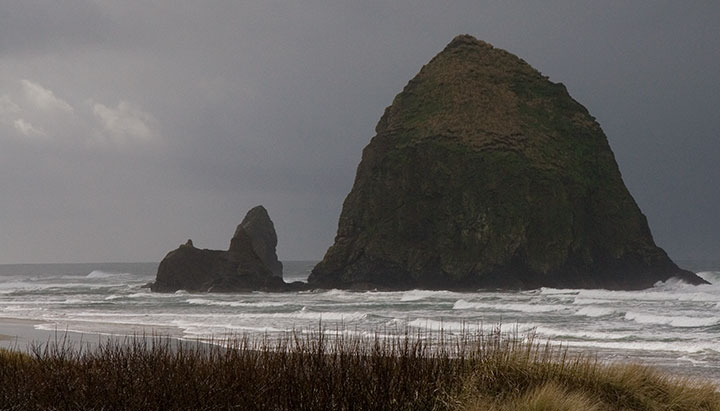
Ah, Cannon Beach. Home of the iconic Haystack Rock and filming location for The Goonies and a whole host of other movies. I would have loved to stay longer, but the only thing likely to roll in that morning wasn’t a pirate ship—
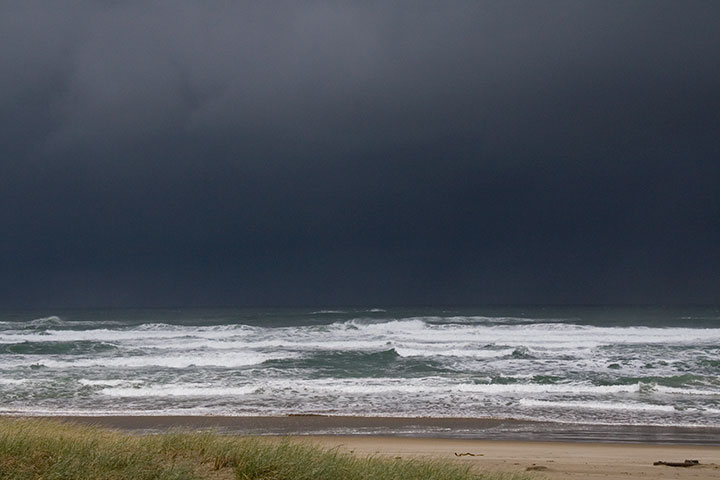
—it was another storm.
I finally managed to tear my eyes from the ominous horizon—less gaping, more fleeing!—but as I turned to walk back to the car, I happened to glance northward:
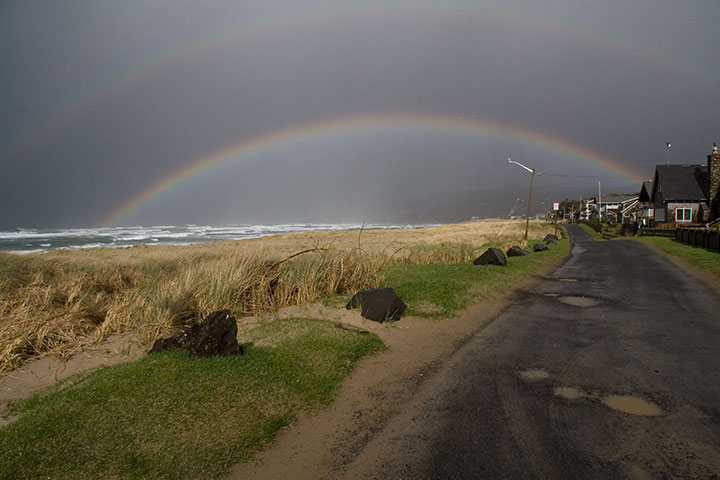
The moment was more like an instant; there was just enough time to let the shutter fly before the light disappeared.
As the first sheet of rain reached me, I jumped in the car and got the heck out of there.
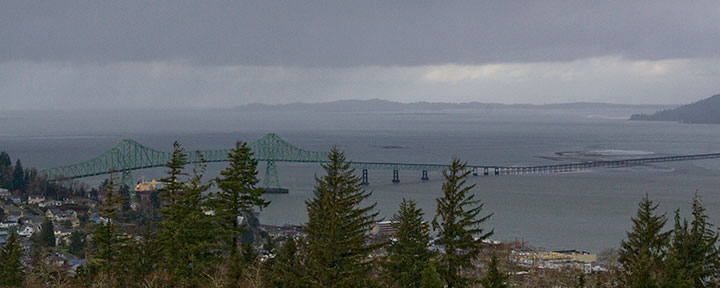
At last I was finally back on my mental map, with just a sliver of Oregon remaining. Within minutes I was perched at the summit of my favorite place to watch the clouds, where the weather is always changing: Astoria.
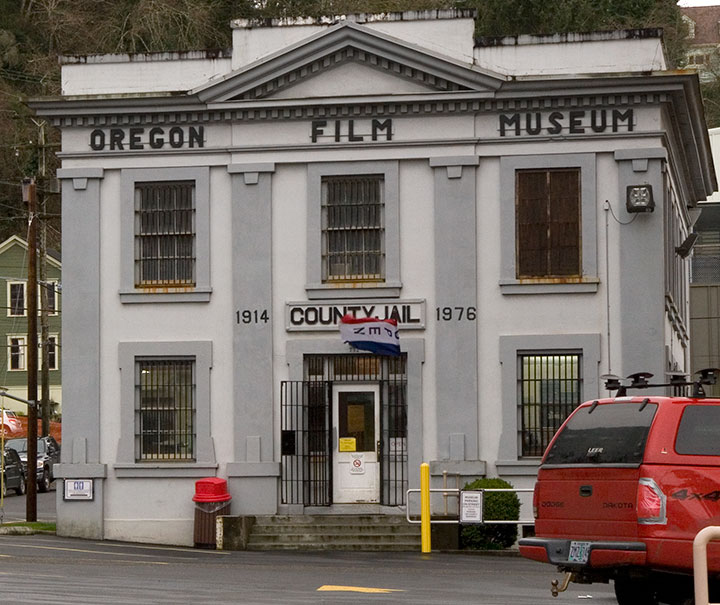
Here, I set about finishing what I started the last time I was in town. Without a detailed map or internet access to tell me where to go, all I could do was wander around. But that’s the best way to explore a place like Astoria—and I found what I was searching for anyway.
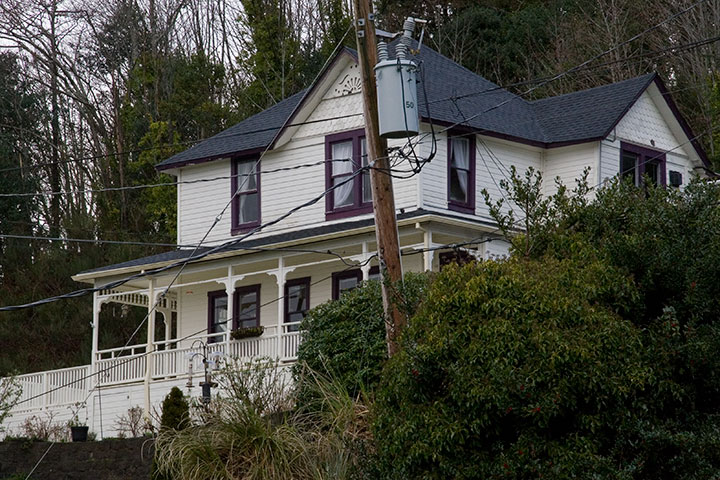
Look familiar?
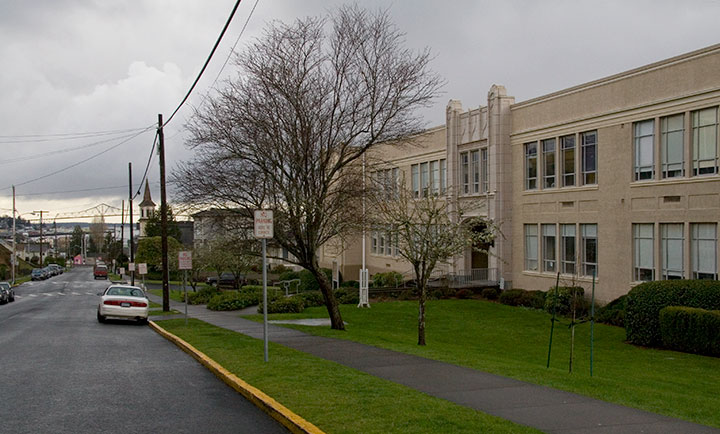
Or how about this place? (Hint: “It’s not a tumor!”)
Even if I hadn’t been location scouting, I had my hands full with a beautiful panorama around every corner. I just love the view of the bridge from here.
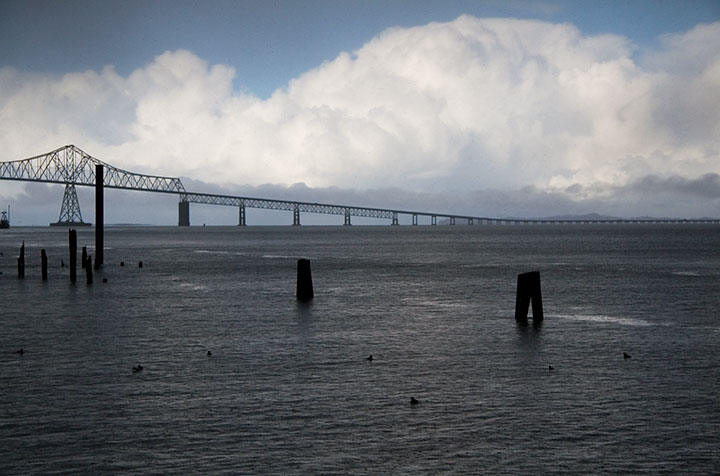
But staring into the mouth of the mighty Columbia, just as the rain turned into a heavy snow squall, reminded me that home was still many miles away—and that I was hoping to get there before dark.
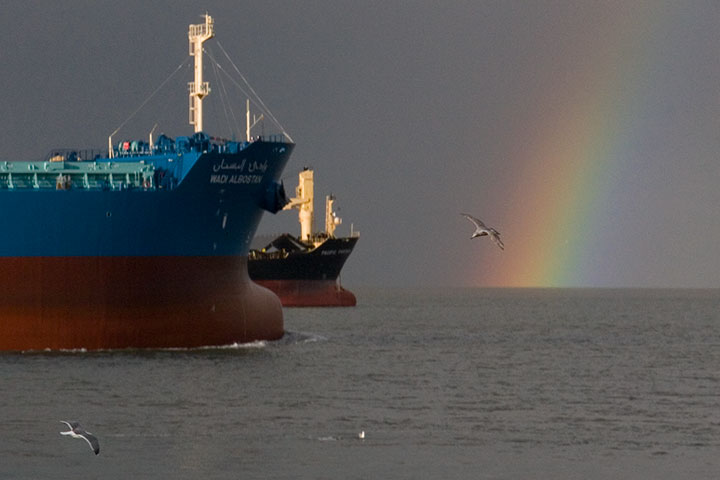
There was just enough time for one final rainbow,
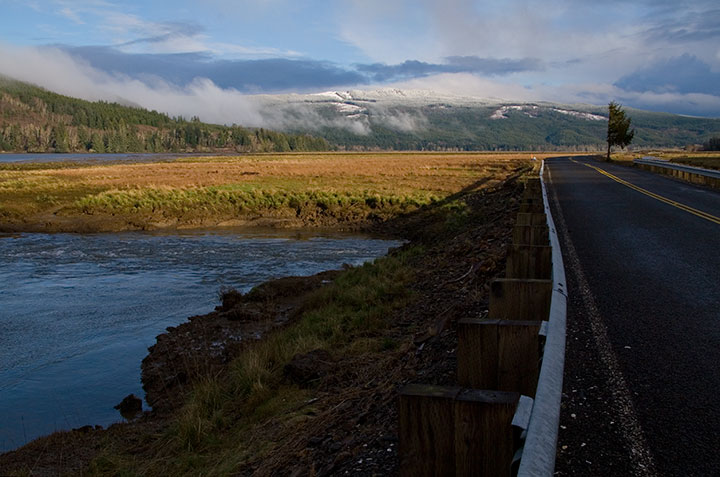
and then I embarked on the last lonely stretch of empty road.
As I pulled over for my last glimpse of the Pacific, I realized that I’d come almost exactly 1000 miles along the coast. Even with six days spent on the road, those miles flashed by entirely too quickly. But then I remembered that I still had the southern half of Highway One left to explore—and the promise of a whole lot of meandering, some day, to get there.
Sounds like a plan.
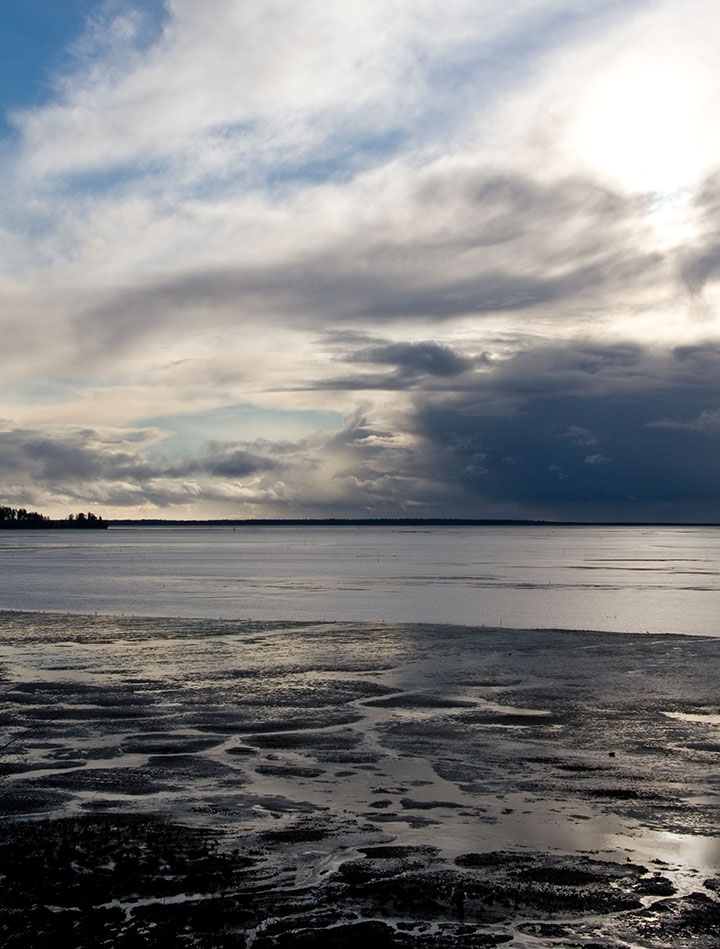
July 7th, 2011
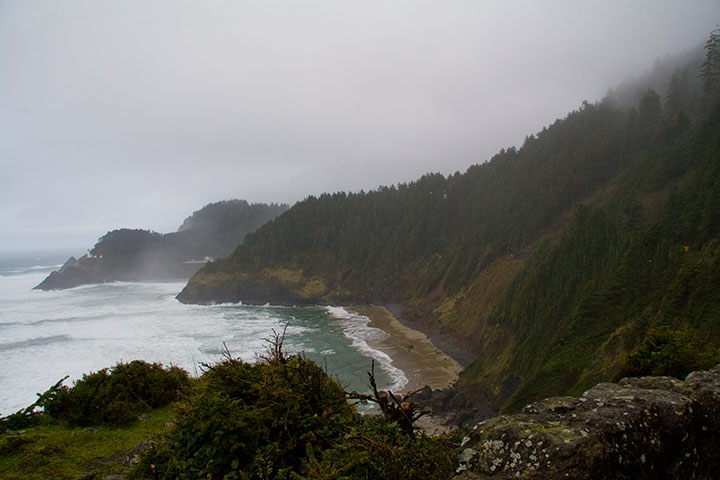
My lucky good weather held out until I hit the Oregon border. And then the storm hit.
It poured. I mean, absolutely cats and dogs.
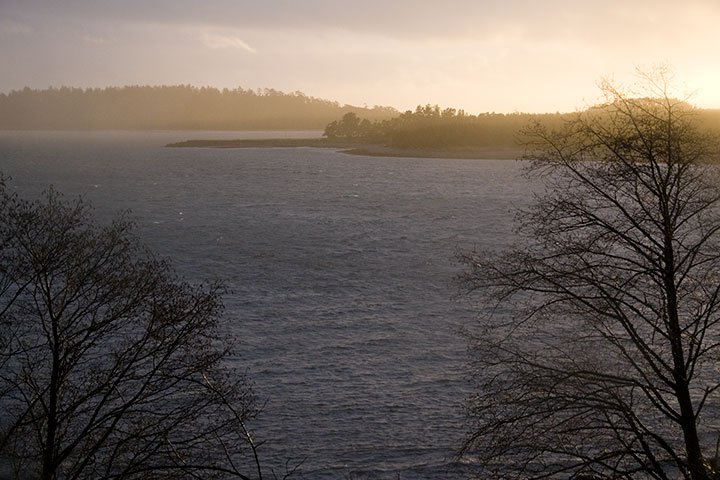
Once in awhile it let up enough to let a hint of sunshine through,
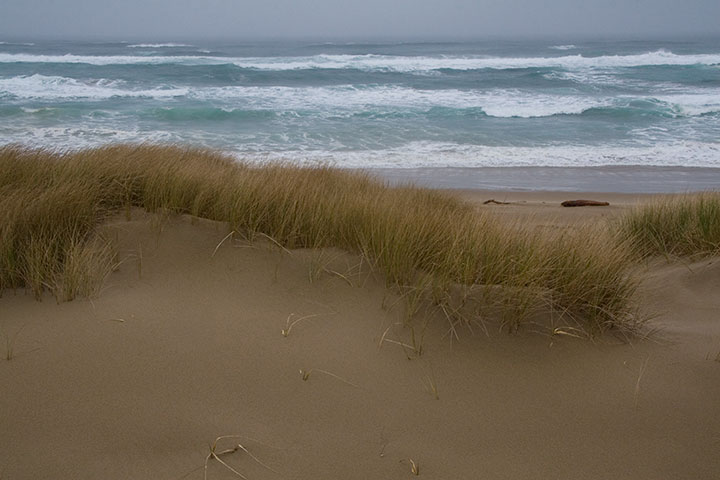
but then the shower curtains would roll back in a moment later.

Sometimes the weather made me laugh out loud. Whenever I’d step out of the car to snap a photo, I’d be buffeted by gale-force winds, and then an invisible person would throw a gallon-sized bucket of icy water right in my face. (Didn’t need coffee to stay awake that day…)
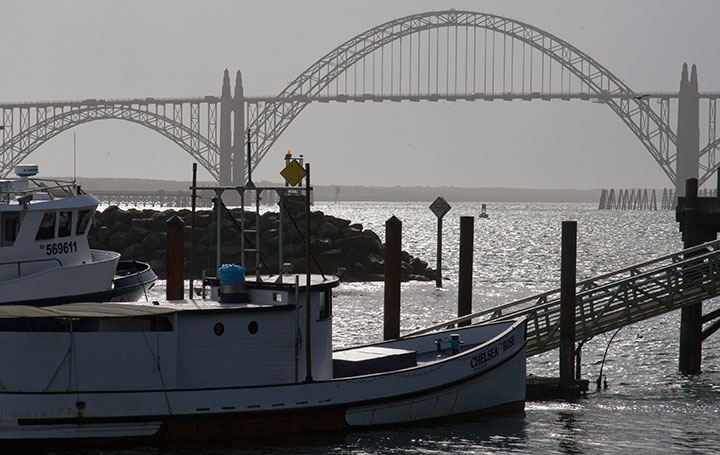
And somehow, it seemed like the quintessential Oregon to me. I think for my maiden voyage up the coast, a monsoon was the appropriate setting; it’s hard to imagine the place in the sun.
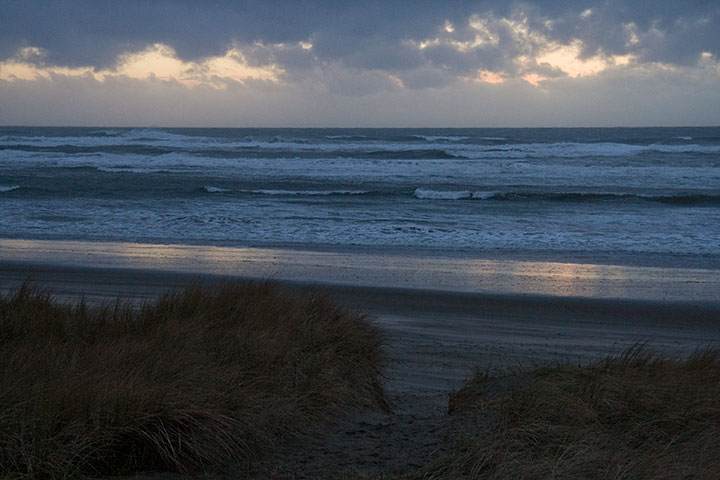
And at the end of the day, I could watch the storm rage and crash from the cozy comfort of a beachfront room. Then I sipped a mug of hot tea, and just listened to the roar of the waves.
June 30th, 2011
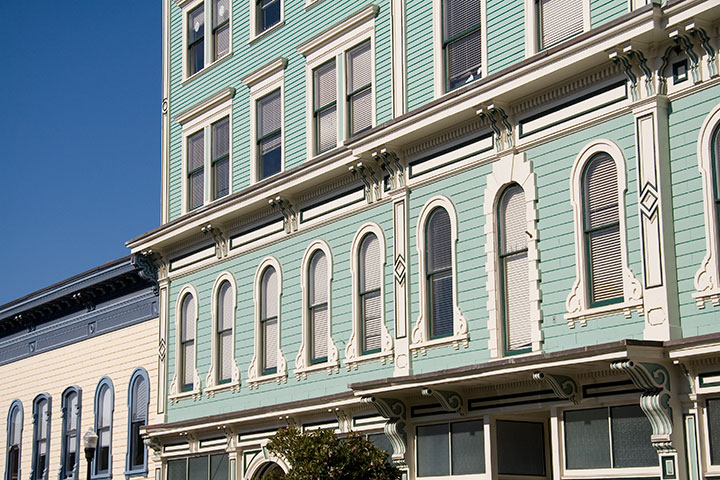
Eureka!
(Sorry. I just felt a great need to say that. Ahem.)
I stopped in Eureka, CA for a cuppa after my sojourn in the nearby redwoods, and was charmed in a heartbeat. Thanks to its obvious proximity to timber, Eureka is chock-a-block with fancy Victorian and Art Deco architecture. And by stumbling upon a book in a shop downtown that day, I discovered it’s not the only town on the Redwood coast that can make that claim. Since one of them was only a few miles back the way I’d come, I turned right around and headed back up the valley to Ferndale.
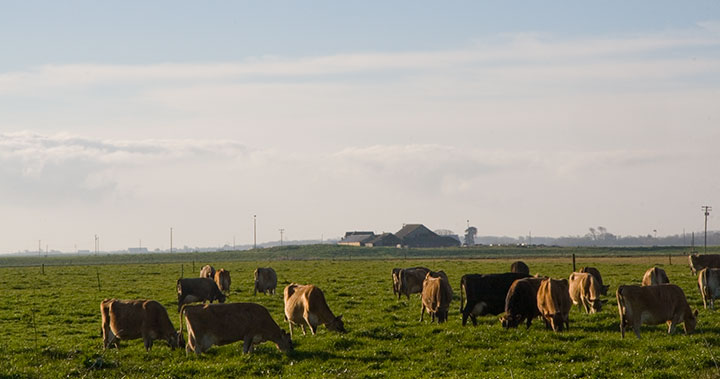
Nicknamed the “Cream City,” Ferndale had its heyday in the 1880s, when the area’s prosperous dairy farms provided much of the wealth that built the town. These affluent farmers built ornate and sumptuous homes there—which the locals called “Butterfat Palaces.”
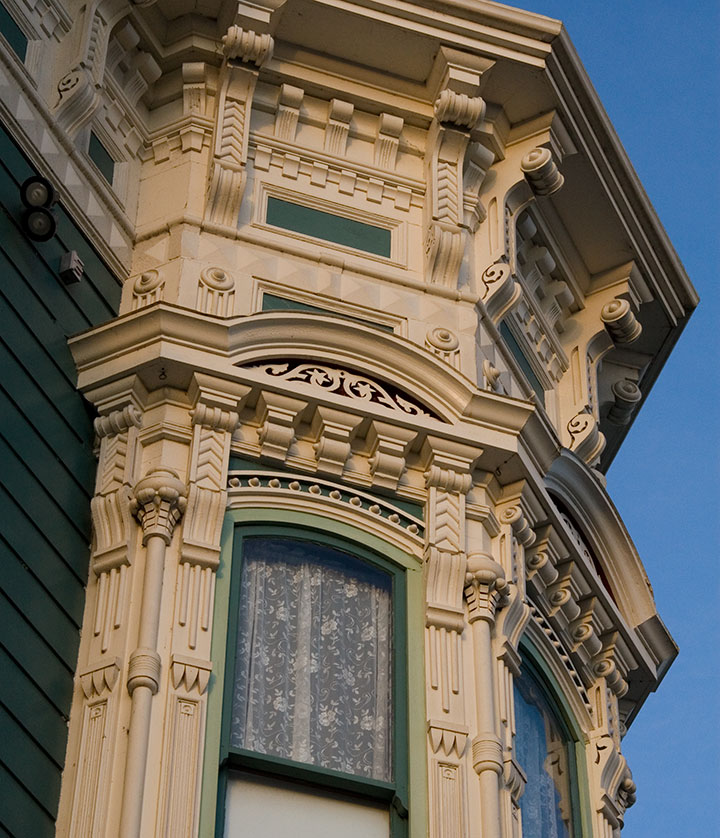
Right away I could see why—when I got to stay in one.
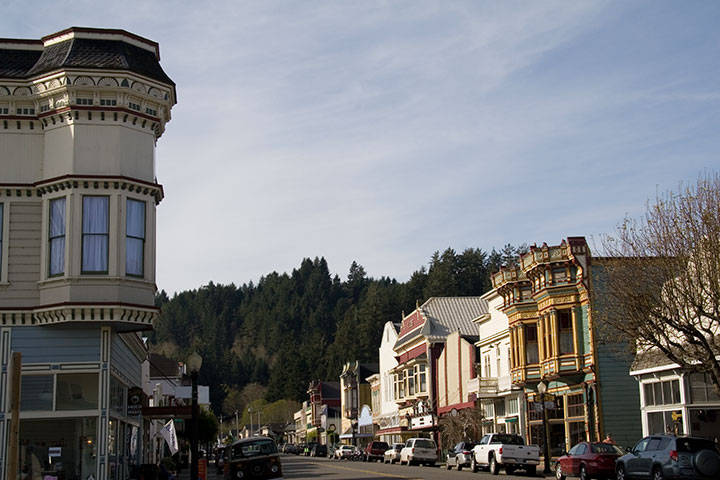
The next morning, after an early breakfast, I took a stroll around town.
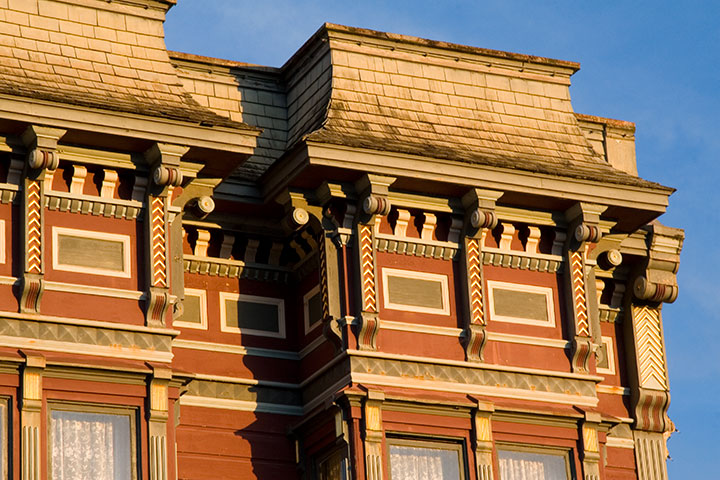
As seemed to be a running theme for my trip, I had the place to myself. The only sounds I heard were mourning doves and lowing cattle—and the early morning glow bathed the buildings in sunlight.
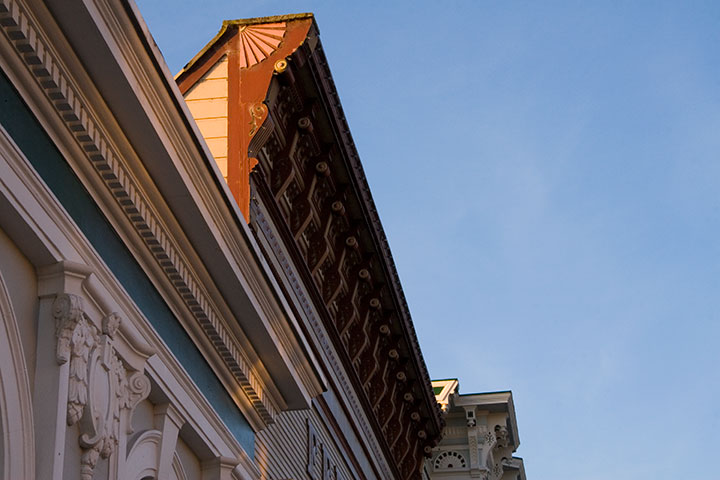
Ferndale is a tiny town; if you add up all its historic buildings you might get three or four city blocks. But the place is worth its weight in butter when it comes to the details.
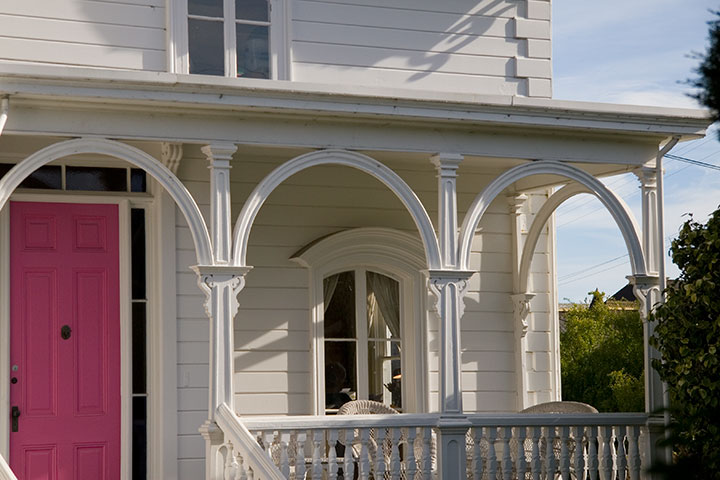
I mean, come on! Just look at that pink door! (I want a pink door on my house!)
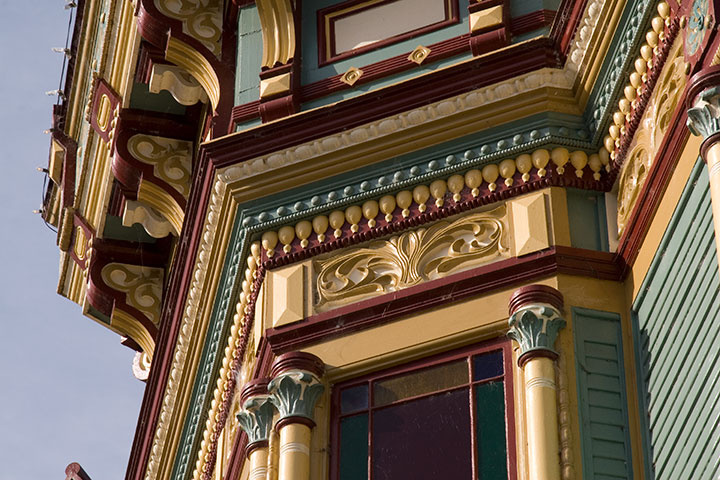
It’s the details that actually played a large part in saving the place from destruction and “urban renewal.” After a series of devastating floods in the mid-20th century, the buildings on main street were slated for demolition. That is, until a local resident bought up every threatened building, then painted them in outrageous Victorian colors—essentially creating the tourist draw the place enjoys today.
I probably could have stared at egg-and-dart cornices all day, but then I turned a corner, and stopped dead in my tracks.
But before I go on, I have to provide a little back story.
The Tailor and I have a tradition of putting together a jigsaw puzzle on New Year’s Day (riveting pastime, I know, but we love it)—we’re always raiding thrift stores in search of the next puzzle. This year’s was an image of an ornate victorian house, in some town I’d never heard of.
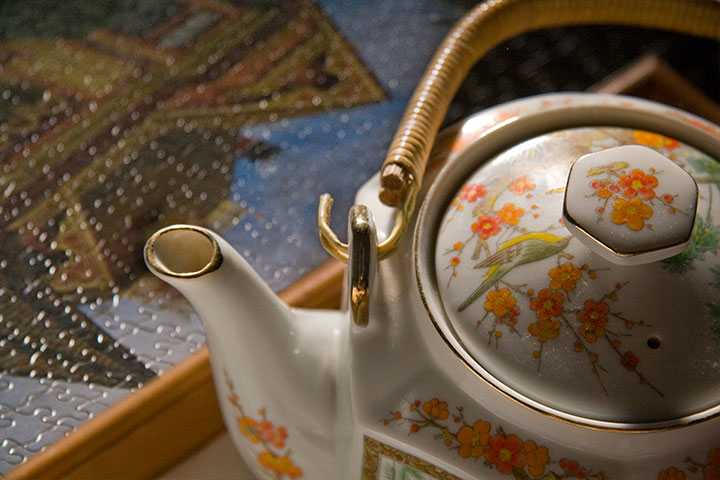
Well, when I turned that corner, I was absolutely gobsmacked to discover it was the jigsaw puzzle house!
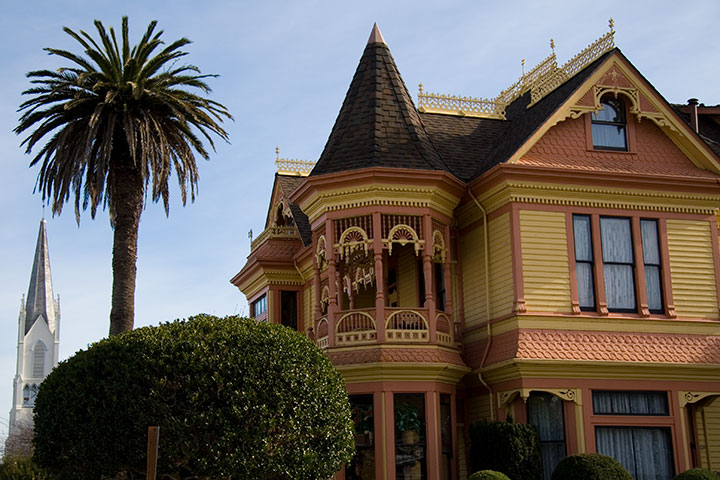
I knew I couldn’t possibly be mistaken—after all, when you reconstruct a building from 1000 pieces of cardboard, you start to memorize the details.
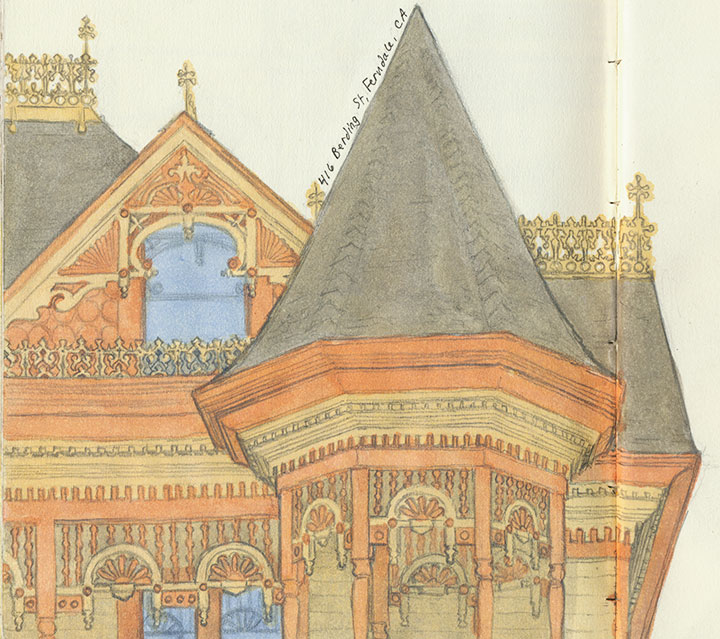
So I plonked myself down on the curb, and started jotting down some of those details in my sketchbook. After all—why settle for a jigsaw puzzle when I had the real thing before me?
June 24th, 2011
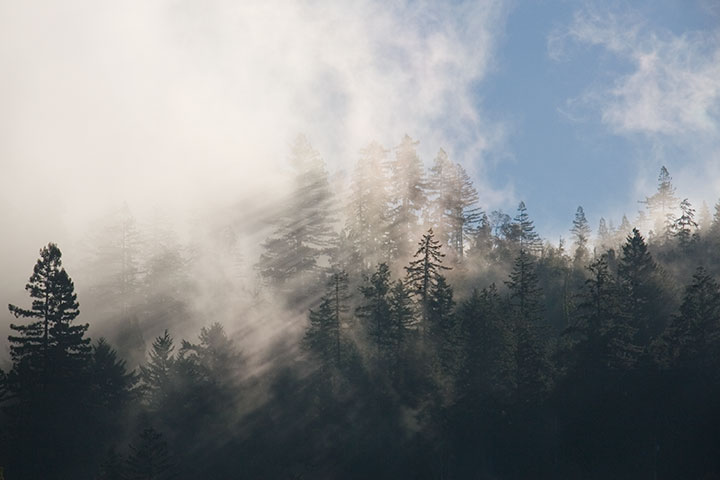
• • • • • • • • • • • • • • • • • • • • • • • • • • • • • • • • • • • • • • • • • • • • • • • • • • • • • • • • • • • • • • • • • • • • • • • • • • •
The tree is more than first a seed, then a stem, then a living trunk,
and then dead timber. The tree is a slow, enduring force straining
to win the sky.
—Antoine de Saint-Exupéry
• • • • • • • • • • • • • • • • • • • • • • • • • • • • • • • • • • • • • • • • • • • • • • • • • • • • • • • • • • • • • • • • • • • • • • • • • • •
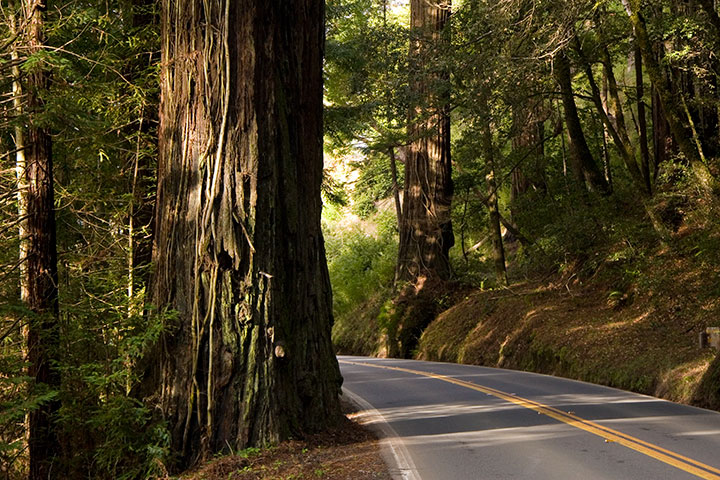
I’ve had four months now to mull over the experience of driving through a redwood forest in the early morning, in complete solitude and silence. And even now, there really are no words to describe it.
Thankfully, though, a redwood forest by its very nature makes it easy to ignore such things. Because my brain certainly wasn’t going to get a handle on what my eyes were seeing—nor was my camera.
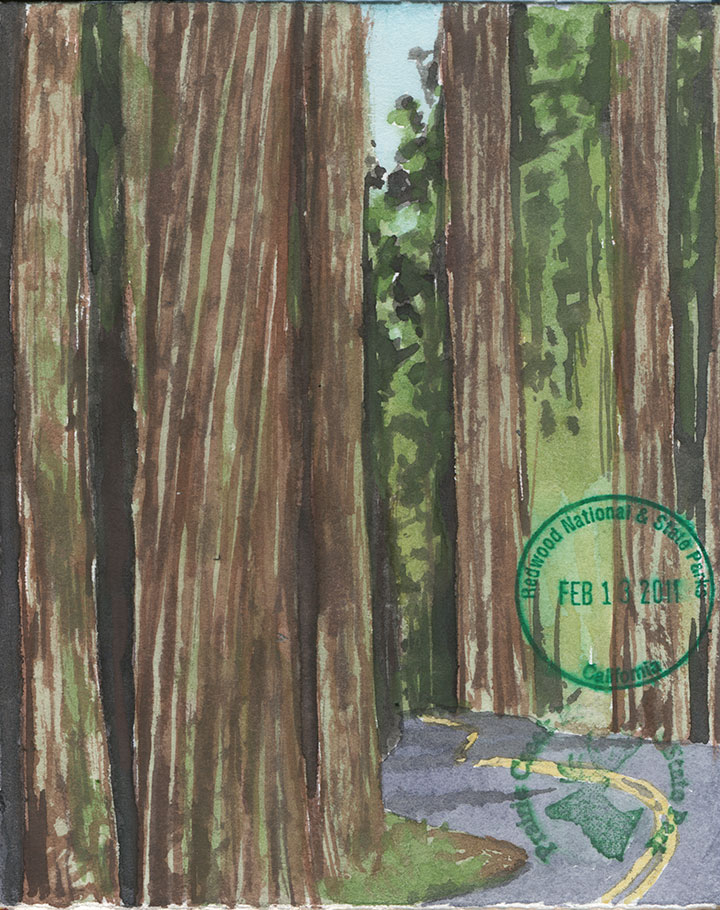
And neither, it turns out, was my paintbrush. I needed a sketchbook that was six inches wide by about twenty feet tall.
And then I realized that I needed a sense of scale, a point of reference. Enter the only other car I saw that morning, and my wide-angle lens.

Eh. That’s still not it.
The only thing to do is to go there in person, crane your neck, and gaze upward in wonder.
June 19th, 2011
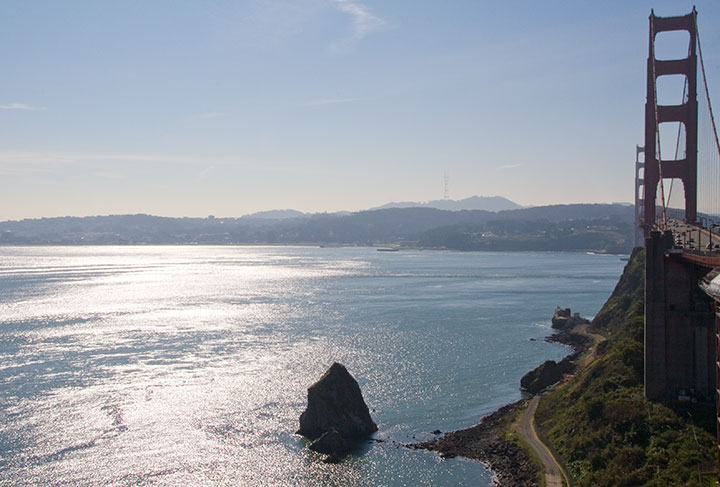
Even though my trip south originally brought me across the Bay, it seemed like San Francisco was the logical starting point for my long trek home along the coast.
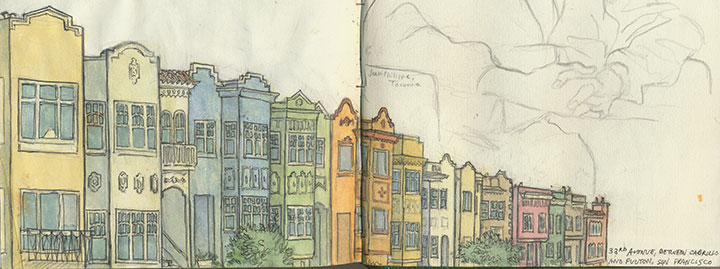
So after a quick sketch (while humming that Journey song that popped into my head for the umpteenth time), I crossed the bridge and headed north.
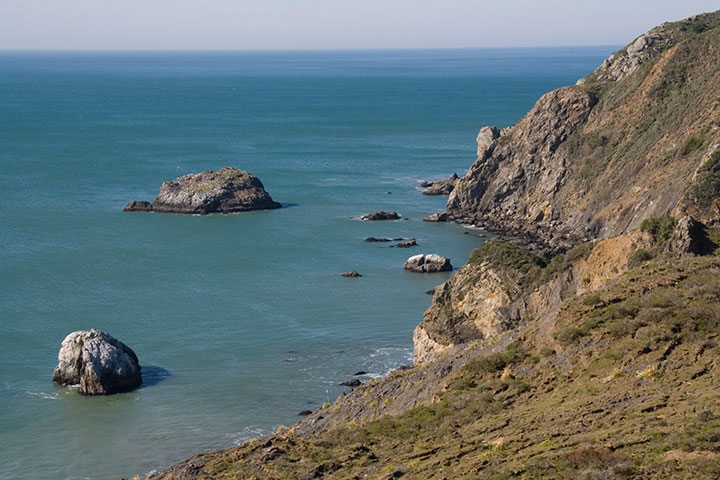
It wasn’t long before I’d left civilization almost completely behind. My chosen route was the (in)famous Highway One, which winds a precarious path along the shore, with breathtaking views and treacherous challenges at every hairpin turn. In other words, it was perfect in nearly every way. Despite the environmental guilt of it all, I confess that I love driving—and hugging the curves of 300 miles of switchbacks in a stick-shift Subaru? Pure, unadulterated bliss. And while I missed the company of the Tailor, or any of my other traditional travel buddies, it was nice to be able to stop and take a picture every thirty seconds, without the risk of annoying anyone!
I knew that by traveling the Coast Highway on a weekday in February, I’d have the place pretty much to myself. But I was completely unprepared for the solitude that awaited me at my first stop along the way: Point Reyes National Seashore.

Point Reyes is a long, jagged cape with an equally long history. Sir Francis Drake reportedly landed there in 1579, and people have inhabited it, farmed it, settled it, and even wrecked their ships upon it for many, many generations. Since the 1850s much of the land has been parceled out into dairy farms, which are still in operation today, thanks to the protection of the National Park Service.
What first struck me about the place is the near total absence of trees. The place reminded me more of the Scottish highlands than anything I’d seen in California—and in fact, one of the few small towns located on the peninsula is called Inverness.
And I’m sure that at the height of summer, the place is crawling with tourists—but that day I was completely alone. For miles and miles and miles, it was just me and the cows.
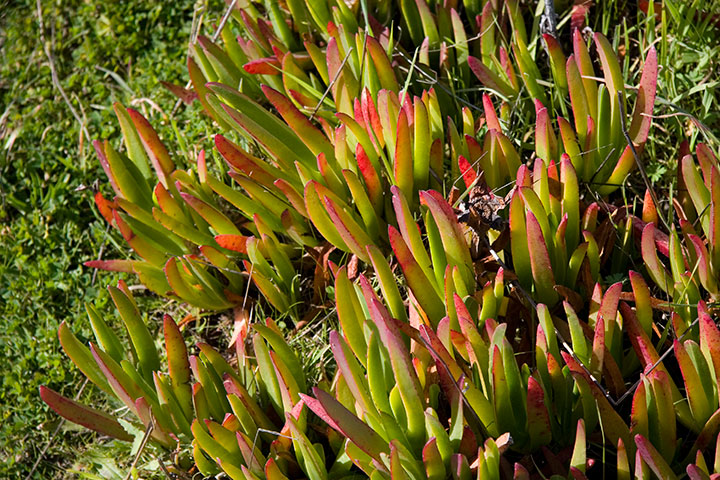
I hadn’t intended to travel the whole length of the cape; I wasn’t on a fixed timetable or anything, but by that point it was already late morning. But I saw a sign indicating a lighthouse ahead, so I kept going. There was no mile count on the sign, and I didn’t bother to fish out the map. It couldn’t be far, right? Well, the road wound on and on and on, with no sign of a lighthouse, and no indication of where this would end. But then, a full twenty miles on, the track came to an abrupt end. I got out of the car, faced back north, and nearly had to pick my jaw up off the ground.

The lighthouse was just a short hike from there:
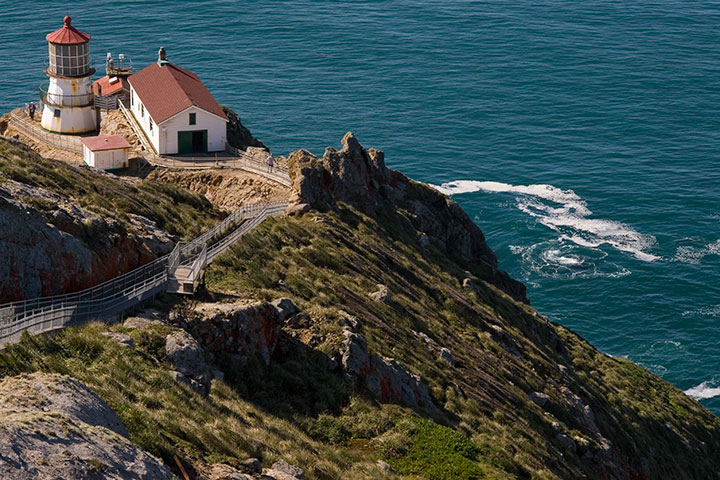
I could see why people were forever dashing their boats upon the rocks.
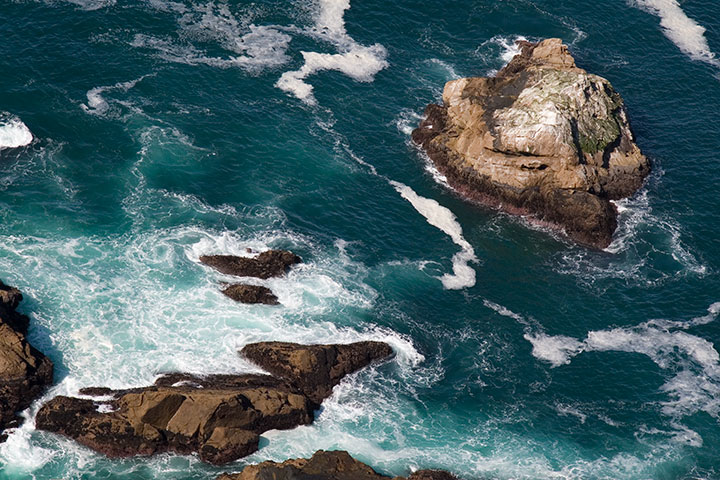
And that wasn’t the only thing I could see. I was staring into the bright teal surf when something surfaced and caught my eye:

A gray whale! It’s funny—I’ve lived on one coast or another for over eleven years of my life, and I’d never seen a whale in person before. If that wasn’t worth the forty-mile detour, I don’t know what is.
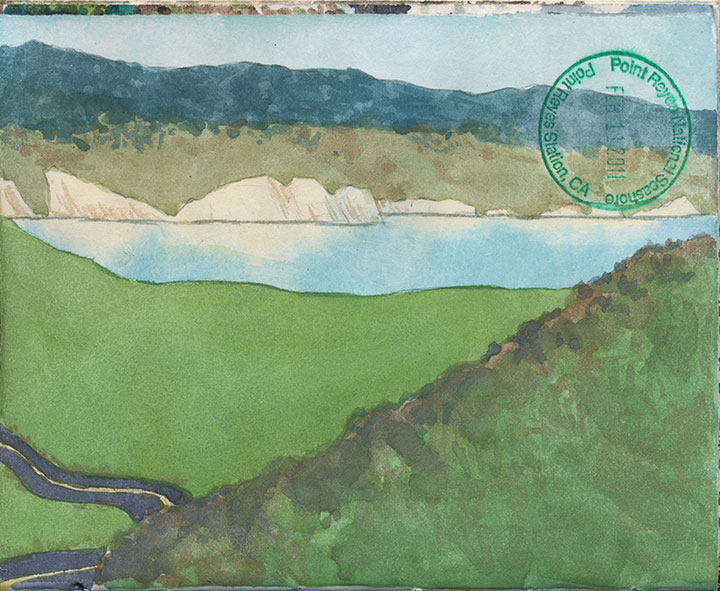
After the whale-watching and a 2-minute watercolor, I made the long trek back to the highway.
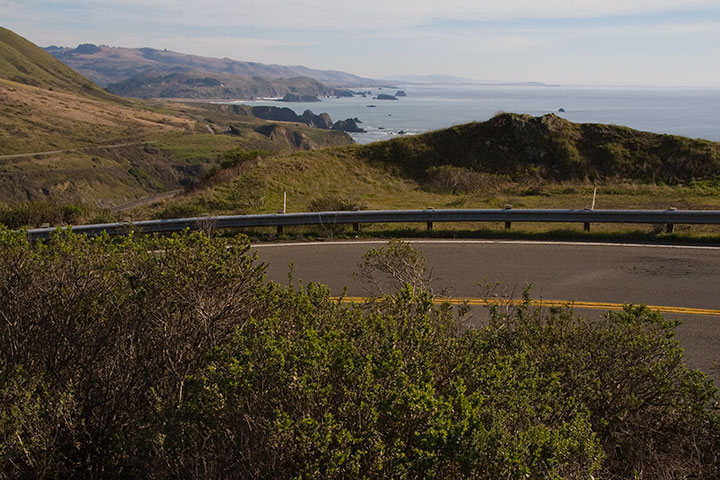
The remaining stretch of Highway One was almost equally deserted. It made the miles melt away quickly, and gave me the feeling that I had the whole Pacific to myself.
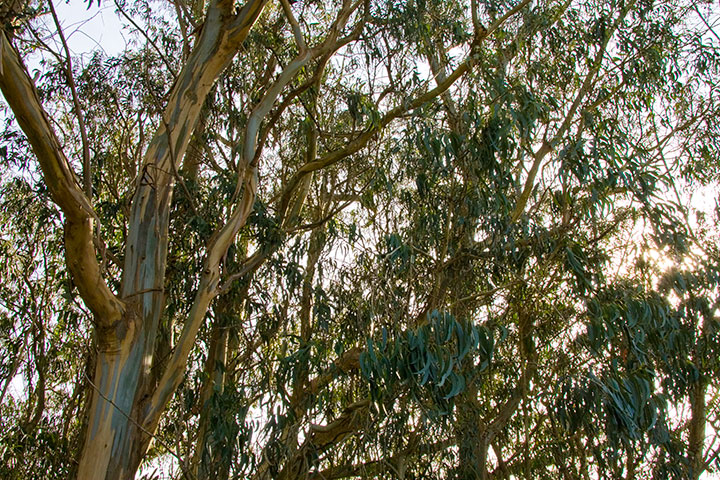
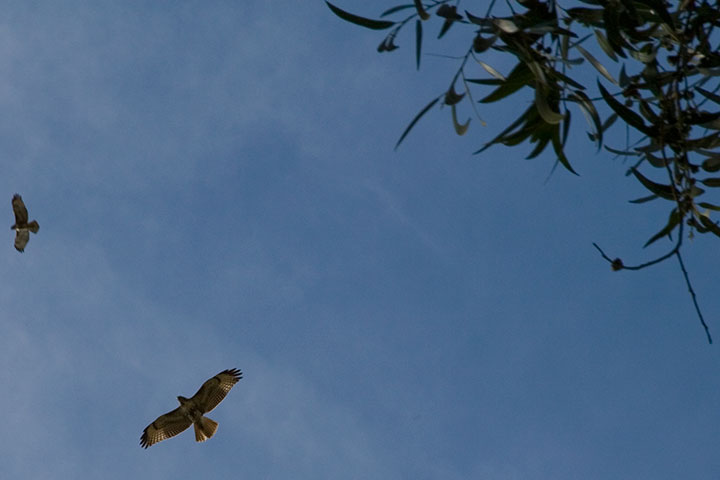
Before long, the rolling hills and eucalyptus trees tapered off,
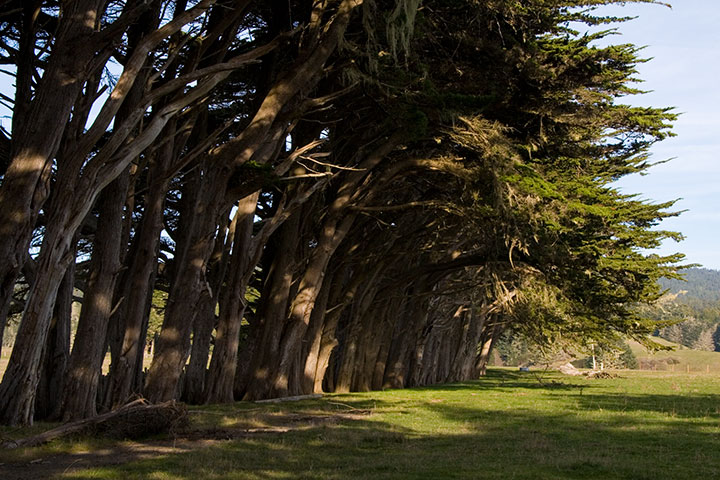
and the landscape gave way to cypress stands and evergreen forests.
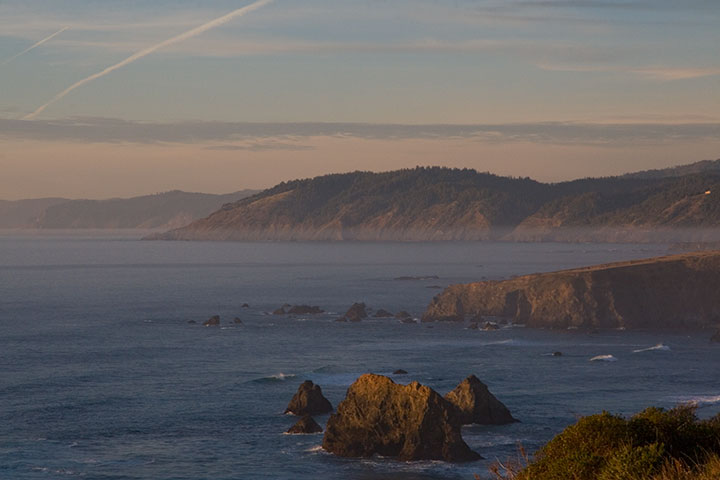
The road ended just as the day did. As the sun went down the path turned eastward, away from the shore, and plunged into the thick darkness of coastal forest. By the time I pulled into a hotel for the night, it was pitch black, and Highway One had been replaced by the other Pacific Highway: US 101. I was in completely unfamiliar territory, and would be until I came all the way north to Astoria several days later, but despite the darkness and lack of bearings, I knew what lay ahead. And I was almost too excited to sleep, because I knew that in the morning, the sun would reveal exactly where I was: in the heart of redwood country.
June 14th, 2011
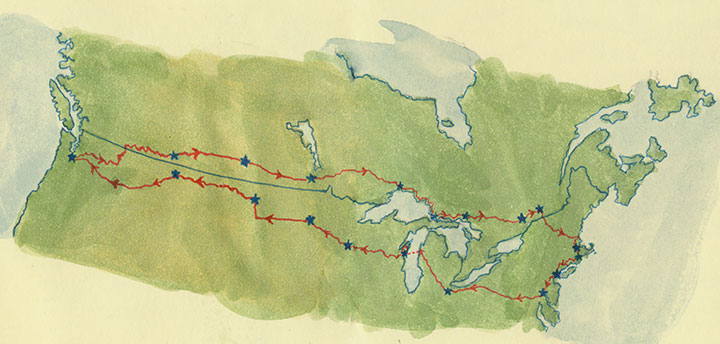
My usually insatiable wanderlust has been at an absolute fever pitch lately—and a pretty intense recent case of studio burnout has only increased the feeling. So in order to recharge the old battery a bit, and maybe stir up some brand new inspiration, I’m closing up shop and hitting the road. The Tailor and I are embarking on an epic five-week cross-country adventure, starting tomorrow morning. Along the way, if all goes according to plan, we’ll visit eighteen states and six Canadian provinces—and probably a host of art supply and camera stores along the way, to keep me stocked with sketchbooks and memory cards.
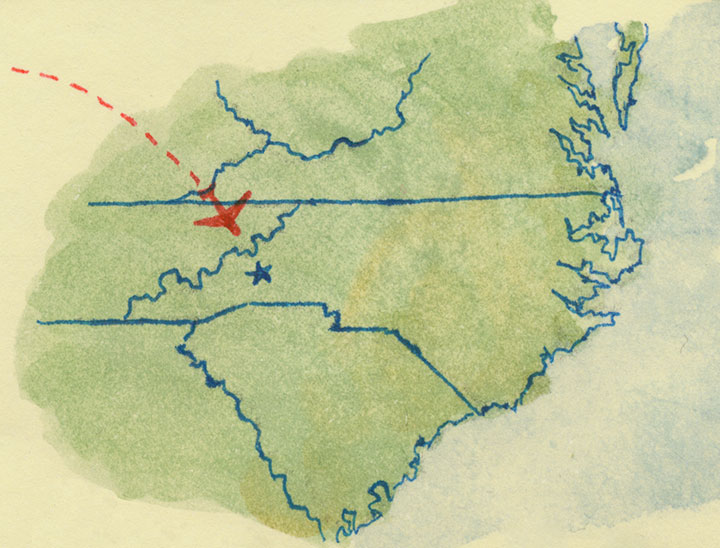
We’ll be back in the third week of July, which will give Jessica and me just enough time to design and print a new Dead Feminist broadside, and then hop a plane with the stack of prints. Jessica and I will be among the presenters at the first annual Ladies of Letterpress Conference in Asheville, North Carolina. If you happen to be local (and since a curiously huge percentage of our customers and followers live in NC, you might be!), swing on by and say hello! The conference will be held on August 5-7—as far as we know, we’ll be up to bat on the first evening.

So as you can see, I’m going to have some blogging to do in the near future. Which reminds me that I never had the chance to report back about my last road trip, down the Pacific Coast. Either time flies, or I’m spinning too many plates. Since I won’t be set up to live-blog from the road this summer, I’ve queued up a series of posts about the Pacific Coast Highway to run while I’m away. It’s almost like being in two places at once!
So anyway, you take the high road, and I’ll take the low road, and we’ll meet up again, at the other end.
May 7th, 2011
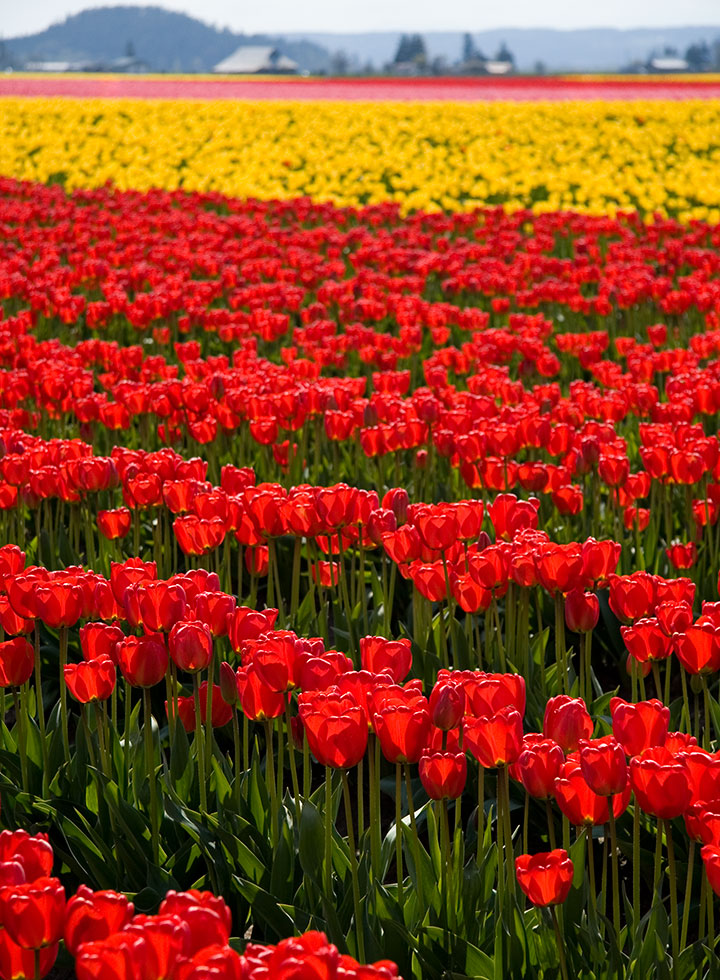
Despite an overabundance of deadlines and studio hubbub lately—well, beautiful spring weather and productivity just don’t mix. Besides, a sunny Friday in the Northwest is basically a license to play hooky. So I took a day off and made my annual pilgrimage up to the Skagit Valley to catch the end of the Tulip Festival.
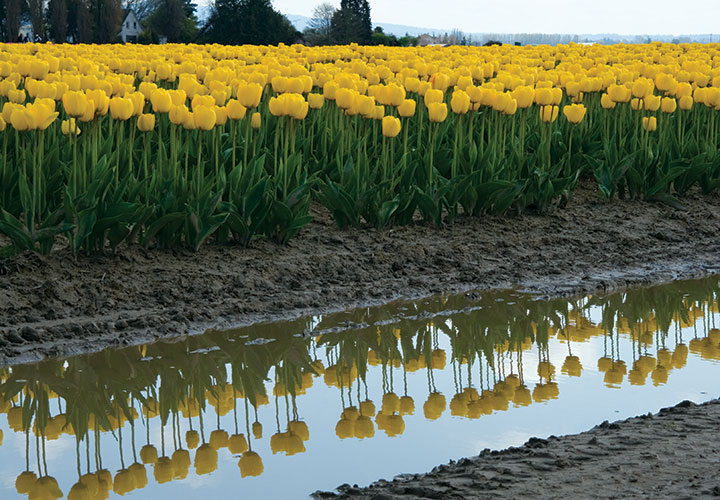
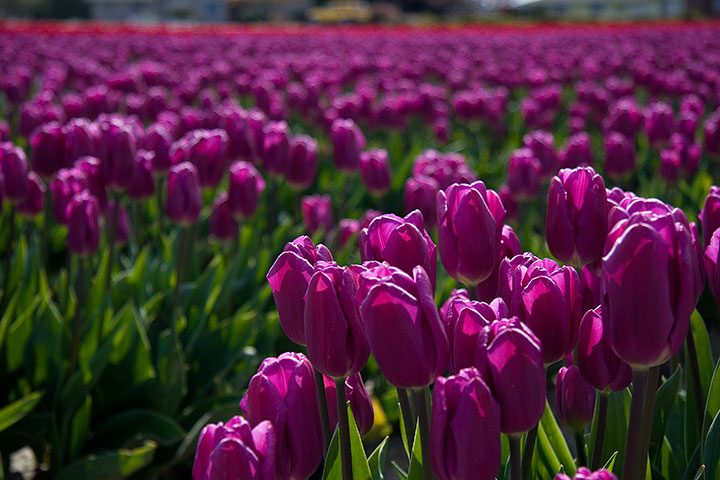
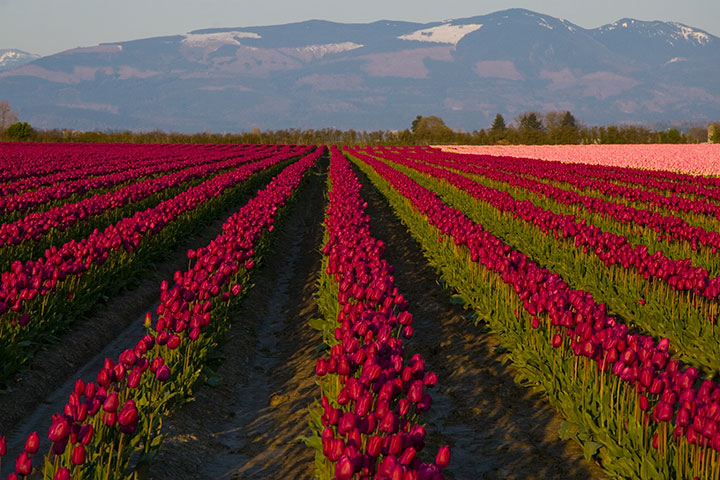
I’m glad I waited this year; not only did the blooms hit a late peak, but the weather was nearly flawless.
Unfortunately, that also meant I wasn’t alone. Finding a shot that didn’t include minivans, port-a-potties, cyclists in DayGlo jackets or entire families striking goofy poses was quite a challenge, and required a lot of waiting and creative cropping.
This time, however, I was interested in far more than just the tulips alone. So I cast a wider net, and found the magic absolutely everywhere I looked. Whenever I wandered away from the fields of pink and red, I seemed to have whole acres to myself.
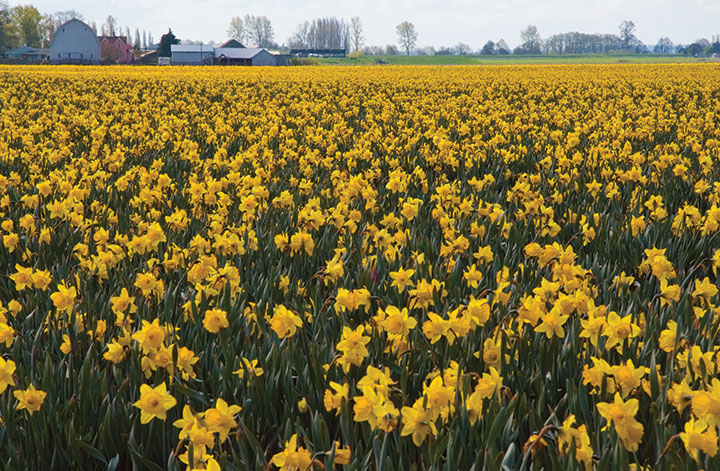
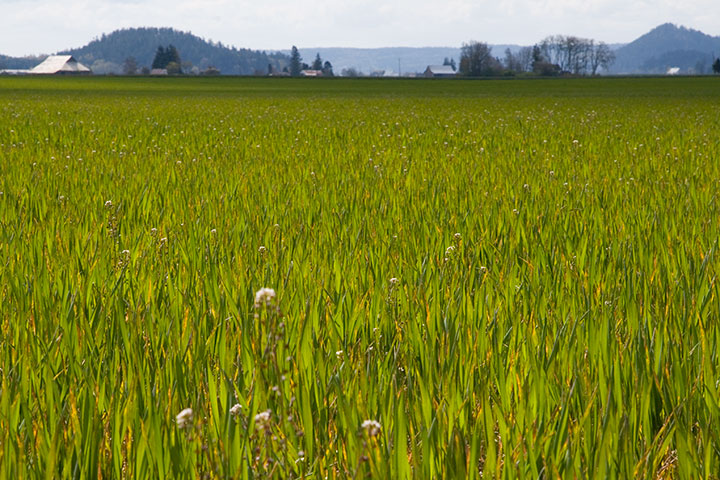
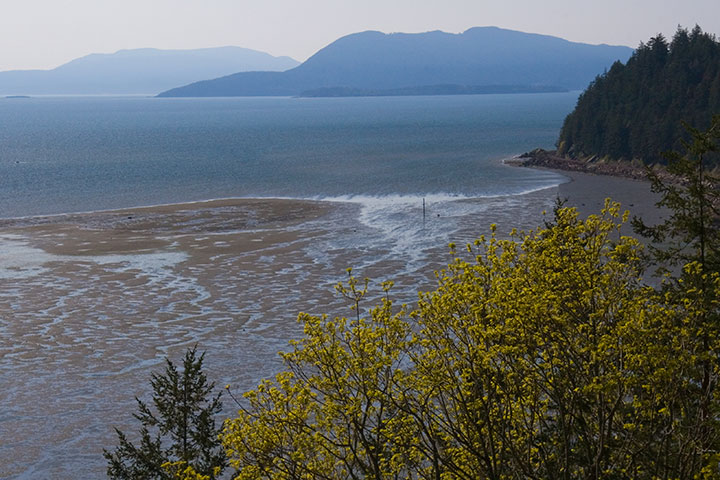
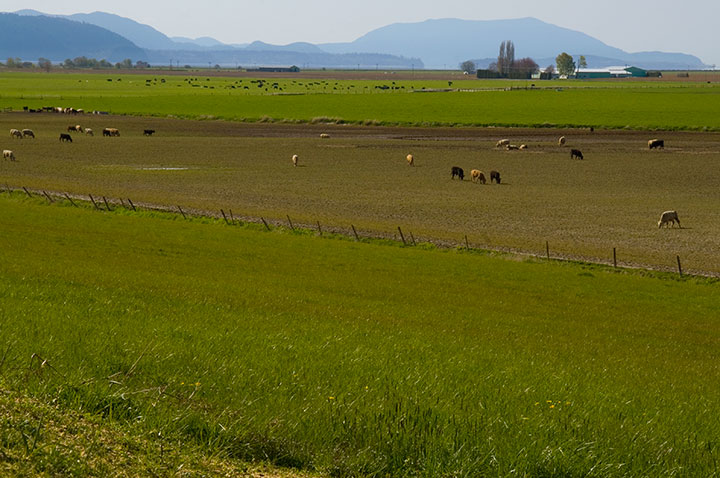
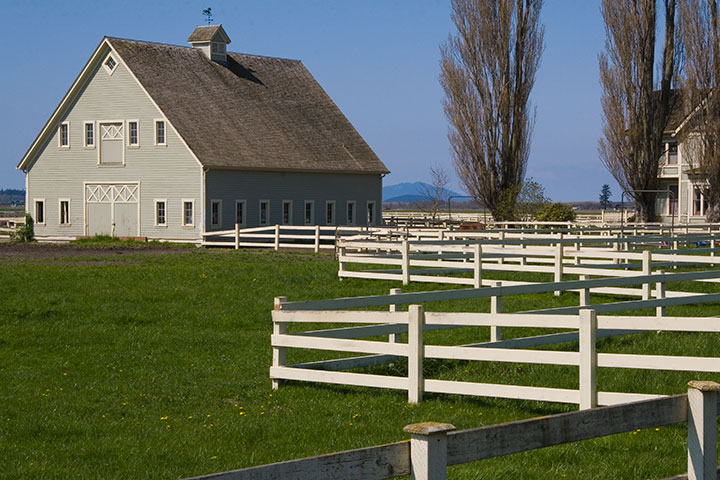
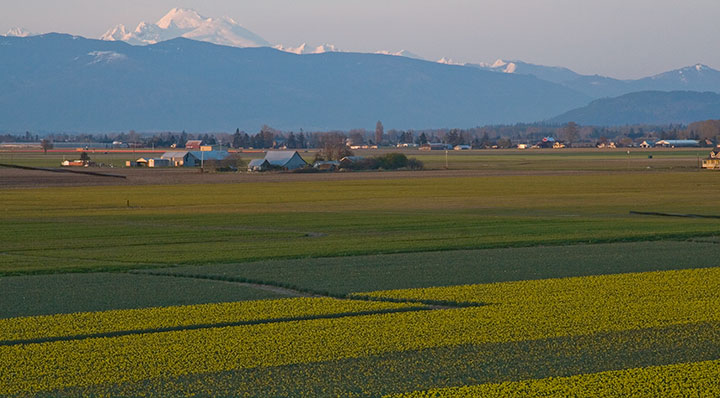
Still, come sunset, the tourists had all gone home, and it was just me, the mountains, and a sea of blooms stretching to the horizon.
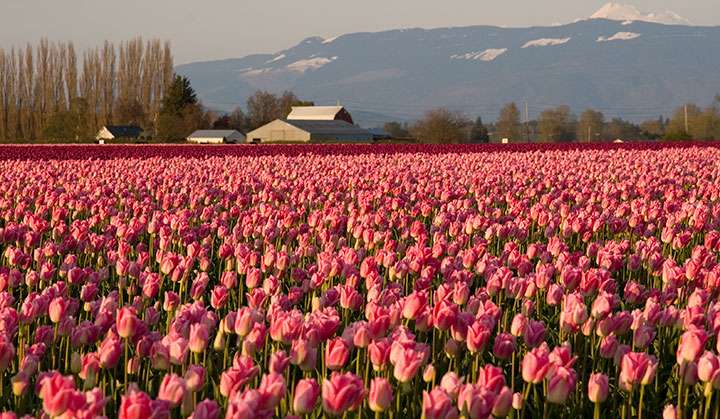

![Chandler O'Leary [logo]](https://chandleroleary.com/wp-content/themes/chandleroleary/images/logo.png)

























































































